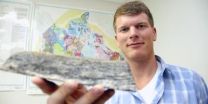(Press-News.org) One of the reasons we don't yet have self-driving cars and mini-helicopters delivering online purchases is that autonomous vehicles tend not to perform well under pressure. A system that can flawlessly parallel park at 5 mph may have trouble avoiding obstacles at 35 mph.
Part of the problem is the time it takes to produce and interpret camera data. An autonomous vehicle using a standard camera to monitor its surroundings might take about a fifth of a second to update its location. That's good enough for normal operating conditions but not nearly fast enough to handle the unexpected.
Andrea Censi, a research scientist in MIT's Laboratory for Information and Decision Systems, thinks the solution could be to supplement cameras with a new type of sensor called an event-based (or "neuromorphic") sensor, which can take measurements a million times a second.
At this year's International Conference on Robotics and Automation, Censi and Davide Scaramuzza of the University of Zurich present the first state-estimation algorithm — the type of algorithm robots use to gauge their position — to process data from event-based sensors. A robot running their algorithm could update its location every thousandth of a second or so, allowing it to perform much more nimble maneuvers.
"In a regular camera, you have an array of sensors, and then there is a clock," Censi explains. "If you have a 30-frames-per-second camera, every 33 milliseconds the clock freezes all the values, and then the values are read in order." With an event-based sensor, by contrast, "each pixel acts as an independent sensor," Censi says. "When a change in luminance — in either the plus or minus direction — is larger than a threshold, the pixel says, 'I see something interesting' and communicates this information as an event. And then it waits until it sees another change."
Featured event
When a standard state-estimation algorithm receives an image from a robot-mounted camera, it first identifies "features": gradations of color or shade that it takes to be boundaries between objects. Then it selects a subset of those features that it considers unlikely to change much with new perspectives.
Thirty milliseconds later, when the camera fires again, the algorithm performs the same type of analysis and starts trying to match features between the two images. This is a trial-and-error process, which can take anywhere from 50 to 250 milliseconds, depending on how dramatically the scene has changed. Once it's matched features, the algorithm can deduce from their changes in position how far the robot has moved.
Censi and Scaramuzza's algorithm supplements camera data with events reported by an event-based sensor, which was designed by their collaborator Tobi Delbruck of the Institute for Neuroinformatics in Zurich. The new algorithm's first advantage is that it doesn't have to identify features: Every event is intrinsically a change in luminance, which is what defines a feature. And because the events are reported so rapidly — every millionth of a second — the matching problem becomes much simpler. There aren't as many candidate features to consider because the robot can't have moved very far.
Moreover, the algorithm doesn't try to match all the features in an image at once. For each event, it generates a set of hypotheses about how far the robot has moved, corresponding to several candidate features. After enough events have accumulated, it simply selects the hypothesis that turns up most frequently.
In experiments involving a robot with a camera and an event-based sensor mounted on it, their algorithm proved just as accurate as existing state-estimation algorithms.
Getting onboard
One of the inspirations for the new work, Censi says, was a series of recent experiments by Vijay Kumar at the University of Pennsylvania, which demonstrated that quadrotor helicopters — robotic helicopters with four sets of rotors — could perform remarkably nimble maneuvers. But in those experiments, Kumar gauged the robots' location using a battery of external cameras that captured 1,000 exposures a second. Censi believes that his and Scaramuzza's algorithm would allow a quadrotor with onboard sensors to replicate Kumar's results.
Now that he and his colleagues have a reliable state-estimation algorithm, Censi says, the next step is to develop a corresponding control algorithm — an algorithm that decides what to do on the basis of the state estimates. That's the subject of an ongoing collaboration with Emilio Frazzoli, a professor of aeronautics and astronautics at MIT.
INFORMATION:
Written by Larry Hardesty, MIT News Office
Think fast, robot
Algorithm that harnesses data from a new sensor could make autonomous robots more nimble
2014-05-29
ELSE PRESS RELEASES FROM THIS DATE:
Minority entrepreneurs face discrimination when seeking loans
2014-05-29
A disheartening new study from researchers at Utah State University, BYU and Rutgers University reveals that discrimination is still tainting the American Dream for minorities.
The three-part research article, which appears online in the Journal of Consumer Research, finds that minorities seeking small business loans are treated differently than their white counterparts, despite having identical qualifications on paper.
While discrimination in housing, employment and education is well documented, the study shows that minorities also face discrimination in the marketplace. ...
Four-billion-year-old rocks yield clues about Earth's earliest crust
2014-05-29
(Edmonton) It looks like just another rock, but what Jesse Reimink holds in his hands is a four-billion-year-old chunk of an ancient protocontinent that holds clues about how the Earth's first continents formed.
The University of Alberta geochemistry student spent the better part of three years collecting and studying ancient rock samples from the Acasta Gneiss Complex in the Northwest Territories, part of his PhD research to understand the environment in which they formed.
"The timing and mode of continental crust formation throughout Earth's history is a controversial ...
Diesel bus alternative
2014-05-29
Electric school buses that feed the power grid could save school districts millions of dollars — and reduce children's exposure to diesel fumes — based on recent research by the University of Delaware's College of Earth, Ocean, and Environment (CEOE).
A new study examines the cost-effectiveness of electric school buses that discharge their batteries into the electrical grid when not in use and get paid for the service. The technology, called vehicle-to-grid (V2G), was pioneered at UD and is being tested with electric cars in a pilot project.
Adapting the system for ...
Stress degrades sperm quality
2014-05-29
Psychological stress is harmful to sperm and semen quality, affecting its concentration, appearance, and ability to fertilize an egg, according to a study led by researchers Columbia University's Mailman School of Public Health and Rutgers School of Public Health. Results are published online in the journal Fertility and Sterility.
According to the American Society for Reproductive Medicine, infertility affects men and women equally, and semen quality is a key indicator of male fertility.
"Men who feel stressed are more likely to have lower concentrations of sperm ...
Rare skin cancer on palms and soles more likely to come back compared to other melanomas
2014-05-29
A rare type of melanoma that disproportionately attacks the palms and soles and under the nails of Asians, African-Americans, and Hispanics, who all generally have darker skins, and is not caused by sun exposure, is almost twice as likely to recur than other similar types of skin cancer, according to results of a study in 244 patients.
The finding about acral lentiginous melanoma, as the potentially deadly cancer is known, is part of a study to be presented May 31 by researchers at the Perlmutter Cancer Center of NYU Langone at the annual meeting of the American Society ...
Better to be bullied than ignored in the workplace: Study
2014-05-29
Being ignored at work is worse for physical and mental well-being than harassment or bullying, says a new study from the University of British Columbia's Sauder School of Business.
Researchers found that while most consider ostracism less harmful than bullying, feeling excluded is significantly more likely to lead job dissatisfaction, quitting and health problems.
"We've been taught that ignoring someone is socially preferable--if you don't have something nice to say, don't say anything at all," says Sauder Professor Sandra Robinson, who co-authored the study. "But ...
Diet and exercise in cancer prevention and treatment: Focus of APNM special
2014-05-29
"Cancer is a leading cause of mortality worldwide and for the foreseeable future...."
This Special Issue titled "The role of diet, body composition, and physical activity on cancer prevention, treatment, and survivorship" comprises both invited reviews and original papers investigating various themes such as the role of omega-3 fatty acids, amino acids, cancer cachexia, muscle health, exercise training, adiposity and body composition.
The Special Editors were David Ma, Department of Human Health and Nutritional Sciences, College of Biological Science, University of ...
'Listening' helps scientists track bats without exposing the animals to disease
2014-05-29
A fungus that infects bats as they hibernate is killing them by the millions, placing three species in the East perilously close to being declared endangered — or perhaps beyond, towards extinction.
How to know the actual condition of the populations of different bat species is challenging.
Now a team of researchers from Virginia Tech, the U.S. Geological Survey, the U.S. Army Installation Command, and the U.S. Army Corps of Engineers has determined the most efficient ways to improve and modify a sampling technique that is already available.
Acoustic monitoring — ...
Family support may improve adherence to CPAP therapy for sleep apnea
2014-05-29
DARIEN, IL – A new study suggests that people with obstructive sleep apnea (OSA) who are single or have unsupportive family relationships may be less likely to adhere to continuous positive airway pressure (CPAP) therapy.
Results show that individuals who were married or living with a partner had better CPAP adherence after the first three months of treatment than individuals who were single. Higher ratings of family relationship quality also were associated with better adherence. Results were adjusted for potential confounding factors including age, gender and body ...
Heavy airplane traffic potentially a major contributor to pollution in Los Angeles
2014-05-29
Congested freeways crawling with cars and trucks are notorious for causing smog in Los Angeles, but a new study finds that heavy airplane traffic can contribute even more pollution, and the effect continues for up to 10 miles away from the airport. The report, published in the ACS journal Environmental Science & Technology, has serious implications for the health of residents near Los Angeles International Airport (LAX) and other airports around the world.
Scott Fruin, D.Env. P.E., Neelakshi Hudda and colleagues note that past research has measured pollution from air ...
LAST 30 PRESS RELEASES:
People with “binge-watching addiction” are more likely to be lonely
Wild potato follows a path to domestication in the American Southwest
General climate advocacy ad campaign received more public engagement compared to more-tailored ad campaign promoting sustainable fashion
Medical LLMs may show real-world potential in identifying individuals with major depressive disorder using WhatsApp voice note recordings
Early translational study supports the role of high-dose inhaled nitric oxide as a potential antimicrobial therapy
AI can predict preemies’ path, Stanford Medicine-led study shows
A wild potato that changed the story of agriculture in the American Southwest
Cancer’s super-enhancers may set the map for DNA breaks and repair: A key clue to why tumors become aggressive and genetically unstable
Prehistoric tool made from elephant bone is the oldest discovered in Europe
Mineralized dental plaque from the Iron Age provides insight into the diet of the Scythians
Salty facts: takeaways have more salt than labels claim
When scientists build nanoscale architecture to solve textile and pharmaceutical industry challenges
Massive cloud with metallic winds discovered orbiting mystery object
Old diseases return as settlement pushes into the Amazon rainforest
Takeaways are used to reward and console – study
Velocity gradients key to explaining large-scale magnetic field structure
Bird retinas function without oxygen – solving a centuries-old biological mystery
Pregnancy- and abortion-related mortality in the US, 2018-2021
Global burden of violence against transgender and gender-diverse adults
Generative AI use and depressive symptoms among US adults
Antibiotic therapy for uncomplicated acute appendicitis
Childhood ADHD linked to midlife physical health problems
Patients struggle to measure blood pressure at home
A new method to unlock vast lithium stores
Scientists unveil “dissolution barocaloric” cooling, opening new path to zero-carbon refrigeration
Microplastics in the atmosphere: Higher emissions from land areas than from the ocean
Metal clumps in quantum state: Vienna research team breaks records
PolyU develops new human-safe magnetorheological fibres, leading innovations in smart wearable textiles
Rice establishes Global Brain Economy Initiative in Davos, aligned with new report on brain health and AI
Quantum error correction with logical qubits
[Press-News.org] Think fast, robotAlgorithm that harnesses data from a new sensor could make autonomous robots more nimble


